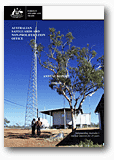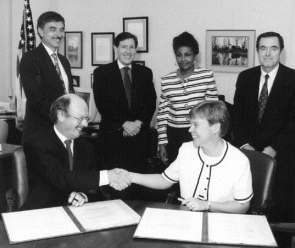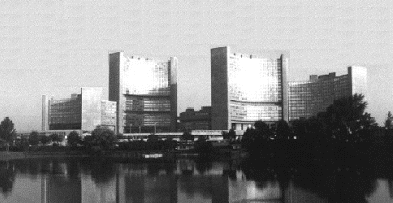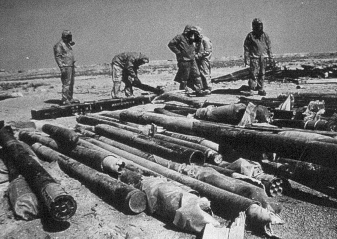


Annual Report 1998-99 |
 |
AUSTRALIAN SAFEGUARDS AND NON-PROLIFERATION OFFICE 1998–99
MINISTER
Administration of the legislation under which ASNO operates, the Nuclear Non-Proliferation (Safeguards) Act 1987, the Chemical Weapons (Prohibition) Act 1994 and the Comprehensive Test-Ban Act 1998, is the responsibility of the Minister for Foreign Affairs, the Hon. Alexander Downer MP.
DIRECTOR GENERAL, ASNO
The position of Director General, ASNO, incorporates the functions of Director of Safeguards, Director, Chemical Weapons Convention Office, and Director, Australian Comprehensive Test-Ban Office.
Outline of Safeguards Role
The position of Director of Safeguards was created in 1987 as a statutory office, appointed by the Governor-General, in order to ensure the independence and integrity of Australia’s domestic and bilateral safeguards functions. The Director of Safeguards reports directly to the responsible Minister, who since 1994 has been the Minister for Foreign Affairs. The legislation requires the Director of Safeguards to prepare an Annual Report for presentation to the Parliament.
Mr John Carlson was appointed as Director of Safeguards in 1989 and as the Director General, ASNO, on 31 August 1998 when ASNO was established.
 |
|
|
Outline of CWC Role
The Chemical Weapons (Prohibition) Act 1994 provides that the Minister may designate a particular office within a Department or agency for which the Minister is responsible, or a statutory office under legislation for which the Minister is responsible, as the office whose occupant is the Director, CWCO. On 11 March 1995 the Minister for Foreign Affairs designated the office of Director of Safeguards for this purpose.
The Director, CWCO, is required to prepare an Annual Report for presentation to the Parliament, and to date this has been incorporated with the Annual Report of the Director of Safeguards.
Outline of CTBT Role
The Director, ACTBO, is likewise to be designated by the Minister under the Comprehensive Nuclear Test-Ban Treaty Act 1998. Although that Act will not commence before the CTBT enters into force (and designation of the Director cannot yet be done), ASNO is already carrying out many of the tasks required of Australia’s CTBT national authority and a report on these activities is included in this Report.
The functions of the Director General, ASNO, include:
- ensuring the effective operation of the Nuclear Non-Proliferation (Safeguards) Act 1987 and the Chemical Weapons (Prohibition) Act 1994, and fulfilment of Australia’s obligations under the treaties these Acts implement;
- ensuring fulfilment of Australia’s obligations under nuclear safeguards agreements, including the agreement with the International Atomic Energy Agency (IAEA) for the application of safeguards pursuant to the Treaty on the Non-Proliferation of Nuclear Weapons (NPT);
- monitoring compliance with the provisions of bilateral nuclear safeguards agreements by Australia’s treaty partners;
- undertaking, coordinating and facilitating research and development (R&D) in relation to nuclear safeguards;
- ensuring the timely and effective establishment of CTBT International Monitoring System (IMS) facilities in Australia, and undertaking preparations to meet the full range of Australia’s obligations under the CTBT when it enters into force; and
- advising the Minister on nuclear non-proliferation and safeguards matters, and on issues related to CWC implementation and CTBT verification.
ASNO has four main areas of responsibility:
- the application of safeguards within Australia,
- the physical protection and security of nuclear items in Australia,
- the operation of Australia’s bilateral safeguards agreements, and
- contributing to the operation and development of international (IAEA) safeguards and the strengthening of the international nuclear non-proliferation regime.
IAEA safeguards are a key element in international action against the spread of nuclear weapons. Effective IAEA safeguards are of vital interest to Australia because of their contribution to global and regional peace and security. They are also important because they underpin Australia’s stringent uranium export policies.
Key safeguards functions include:
- ensuring Australia’s bilateral safeguards agreements are implemented satisfactorily, that is to guarantee Australia’s nuclear exports remain in exclusively peaceful use; ensuring that conditions which Australia places on the use of Australian Obligated Nuclear Material (AONM), additional to IAEA safeguards, are met (these conditions are outlined in Australia's Uranium Exports);
- accounting for, and making independent evaluations of, exported uranium ore concentrates, and for the nuclear material derived from its processing and use (collectively known as AONM), as it moves through the fuel cycles of Australia’s bilateral partners;
- ensuring that all AONM is subject to IAEA safeguards, and verification of non-diversion is carried out by the IAEA;
- ensuring that any nuclear items other than nuclear material (i.e. associated material, equipment and technology) which are transferred to a third party are properly accounted for and that the relevant records of Australia’s partners are consistent with ASNO records;
- pursuant to obligations under the Convention on the Physical Protection of Nuclear Material (CPPNM), and following IAEA guidelines, ensuring that appropriate security measures are applied to nuclear items in Australia;
- contributing to the development and effective implementation of IAEA safeguards through activities such as participation in expert groups and international meetings on safeguards, field testing of new safeguards methods in Australia, and presentation of regional training courses on safeguards techniques;
- managing Australia’s Support Program for IAEA safeguards, which embraces R&D work and includes consultancy tasks for the IAEA;
- evaluation of the effectiveness of IAEA safeguards as a basis for advising Government;
- contributing to the development of Australia’s policies in the area of disarmament and non-proliferation by colleagues in the International Security Division (ISD) of DFAT; and
- working closely on technical issues of common interest with agencies such as ANSTO, the Australian Radiation Protection and Nuclear Safety Agency (ARPANSA), the Defence Intelligence Organisation (DIO), and the Office of National Assessments (ONA).
 |
|
ASNO is the focal point in Australia for liaison between stakeholders, such as operators of declared facilities, the Organisation for the Prohibition of Chemical Weapons (OPCW), and the national authorities of other States Parties on issues relating to national implementation of the Convention. The role here is primarily one of liaison and facilitation, to ensure that Australia’s international obligations under the CWC are met, and that the rights of facility operators are protected.
ASNO is also responsible for ensuring that the requirements of the Chemical Weapons (Prohibition) Act 1994 are met, and may conduct national compliance inspections of relevant chemical facilities. While the Act makes provision for national inspectors to obtain mandatory access to sites, it is expected such powers will be exercised only in exceptional circumstances.
ASNO provides technical support to DFAT in development of a verification protocol for the Biological and Toxin Weapons Convention (BWC). Once the provisions of this protocol are settled, and as Australia moves towards protocol ratification, it is envisaged that ASNO will be expanded to embrace BWC responsibilities similar to those it holds under the CWC.
Key CWC functions include:
- identifying and gathering information on industrial chemical facilities and activities required to be declared to the OPCW;
- working with declarable facilities to prepare for the possibility of OPCW inspection;
- increasing awareness of the CWC and Australia’s obligations by disseminating information on the Convention and the Chemical Weapons (Prohibition) Act 1994 to the chemical industry and other domestic entities likely to be affected;
- administering and developing regulatory, administrative and logistical mechanisms to enable Australia to fulfil its CWC obligations;
- liaising with overseas counterpart organisations and with the Technical Secretariat of the OPCW in connection with practical implementation issues;
- conducting research directed towards improving the effectiveness of the CWC’s verification regime;
- assisting, upon request, other States Parties to implement the CWC, particularly in Australia’s immediate region; and
- providing technical advice to support Australia’s delegation at the BWC verification protocol negotiations.
 |
|
supervision at Khamsiyah, Iraq - Photograph courtesy of DSTO |
ASNO is the main point of contact between Australia and the Provisional Technical Secretariat (PTS) of the CTBT Organisation (CTBTO) in Vienna. Overall, the role is one of liaison and facilitation to ensure that the International Monitoring System is established efficiently and relevant domestic regulations are passed.
Key CTBT functions include:
- being the national point of contact for liaison on CTBT implementation;
- establishing and maintaining legal, administrative and financial mechanisms to give effect to the CTBT in Australia;
- developing arrangements for the operation of Australia’s National Data Centre and preparing for possible on-site inspections in Australia;
- promoting an understanding in Australia of CTBT verification, including by acting as an interface between technical and policy specialists; and
- contributing to the work of the CTBTO Preparatory Commission and its working groups.
ADVICE TO THE GOVERNMENT
The staff of ASNO have substantial experience in international and bilateral safeguards, CWC verification issues and CTBT processes and procedures. Drawing on this expertise and an international network of contacts in other governments and organisations, ASNO provides technical and policy advice to the Government and other bodies.
LEGISLATION
Nuclear Non-Proliferation (Safeguards) Act 1987
The Nuclear Non-Proliferation (Safeguards) Act 1987 (the Safeguards Act) took effect on 31 March 1987. This Act establishes the statutory office of Director of Safeguards and forms the legislative basis for ASNO’s nuclear safeguards activities.
The Safeguards Act gives effect to Australia’s safeguards obligations under:
- the NPT;
- Australia’s NPT safeguards agreement with the IAEA;
- agreements between Australia and various countries (and Euratom) concerning transfers of nuclear items, and cooperation in peaceful uses of nuclear energy; and
- the CPPNM.
Control over nuclear material and associated items in Australia is exercised under the Safeguards Act by a system of permits for their possession and transport. Communication of information contained in sensitive nuclear technology is controlled through the grant of authorities.
The Safeguards Act empowers the Minister to grant, vary or revoke permits or authorities, to make declarations or orders in relation to material, equipment or technology covered by the Act, and to appoint inspectors to assess compliance with the Act and with Australia’s NPT safeguards agreement with the IAEA. The Minister has delegated most of these powers (with certain exceptions such as powers to make declarations and orders) to the Director of Safeguards.
Regulations and declarations under this Act are listed under the Freedom of Information Act 1982 statements page of this Report.
Nuclear Non-Proliferation (Safeguards) (Consequential Amendments) Act 1988
The Nuclear Non-Proliferation (Safeguards) (Consequential Amendments) Act 1988 took effect on 24 May 1988. It amended the Patents Act 1952 to allow referral from the Patent Office to the Director of Safeguards patent applications which might constitute ‘associated technology’ under the Safeguards Act. The amendments give the Director of Safeguards the power to direct that such a patent application lapse if the applicant does not hold an appropriate authority under the Safeguards Act to communicate sensitive information at the time of making the application for the patent.
Nuclear Safeguards (Producers of Uranium Ore Concentrates) Charge Act 1993
In conjunction with an amendment to the Safeguards Act, this legislation imposes an annual charge on uranium producers corresponding to a proportion of ASNO’s operating costs. Further details see Uranium Producers Charge.
South Pacific Nuclear Free Zone Treaty Act 1986
The South Pacific Nuclear Free Zone Treaty (SPNFZ) Act 1986 prohibits the manufacture, production, acquisition, stationing and testing of nuclear explosive devices, and R&D relating to manufacture or production of nuclear explosive devices.
The SPNFZ Act establishes the framework for inspections in Australia by Treaty inspectors, and provides for appointment by the Minister for Foreign Affairs of authorised officers to accompany and observe international inspectors while they are in Australia. Inspectors appointed for the purposes of the Safeguards Act are also inspectors under the SPNFZ Act. These inspectors are to assist Treaty inspectors and authorised officers in carrying out Treaty inspections, and investigating possible breaches of the SPNFZ legislation in Australia.
Chemical Weapons (Prohibition) Act 1994
The Chemical Weapons (Prohibition) Act 1994 was enacted on 25 February 1994. Division 1 of Part 7 of the Act (establishing the CWCO and the position of its Director), and sections 95, 96, 97, 99, 102, 103, and 104 were proclaimed on 15 February 1995. Other provisions of the Act which expressly relied on the CWC came into effect on 29 April 1997 when the CWC entered into force. In conjunction with other legislation (see under the following heading), the Act gives effect to Australia’s obligations, responsibilities and rights as a State Party to the CWC. In particular, it:
- prohibits activities connected to the development, production or use of chemical weapons, including assisting anyone engaged in these activities, whether intentionally or recklesslysuch offences are punishable by life imprisonment;
- establishes permit and notification systems to provide a legal framework for the compulsory provision of data to CWCO (ASNO) by facilities which produce or use chemicals as specified by the Convention, so that ASNO can lodge declarations with the OPCW;
- provides for routine inspections of declared facilities and challenge inspections of any facility or other place in Australia by OPCW inspectors to verify compliance with the CWC, and for inspections by CWCO to verify compliance with the Act; and
- provides for procedures should another State Party seek clarification concerning compliance with the Convention by any facility or other person or place in Australia.
Regulations under the Act prescribe procedures and details of other arrangements provided for in the Act. In particular, the Regulations define conditions that are to be met by holders of permits issued under the Act, and for granting privileges and immunities to OPCW inspectors when in Australia to carry out an on-site inspection.
The text of the CWC is reproduced in the Schedule to the Act. The manner in which any powers are exercised under the Act must be consistent with the Convention, and have regard to Australia’s obligations under it.
The Chemical Weapons (Prohibition) Act 1994 was amended on 6 April 1998. The amendments refine administration of the Act by simplifying compliance obligations for facilities requiring permits, clarifying the legislative basis for Australia to implement some of its obligations under the Convention, correcting drafting errors and improving certain procedures, including those related to secrecy. For consistency, concomitant Regulations were amended on 17 December 1998.
Other CWC related legislation
Other aspects of the CWC which required legislation have been, or are being, dealt with under existing legislation, in particular the:
· Customs (Prohibited Exports) Regulations and Customs (Prohibited Imports) Regulations, to enforce CWC obligations in relation to export and import controls on scheduled chemicals; and
· International Organisations (Privileges and Immunities) Act 1963, to recognise the OPCW as an international organisation, and to grant appropriate privileges and immunities to its officers when in Australia for official purposes.
Comprehensive Nuclear Test-Ban Treaty Act 1998
The Act gives effect to Australia’s obligations as a Party to the Comprehensive Nuclear-Test-Ban Treaty (CTBT). It prohibits the causing of any nuclear explosion at any place under Australian control and establishes a penalty of up to life imprisonment for an offence against the provision. The Act also prohibits Australian nationals from causing a nuclear explosion in any place outside Australian control.
The Act requires the Commonwealth Government to facilitate verification of compliance with the Treaty provisions, including the obligation to facilitate the establishment and operation of Australian monitoring stations and the provision of data from them. It provides the Commonwealth with the authority to establish IMS stations and make provision for access to them for CTBT monitoring purposes. The Act also makes provision for the Minister for Foreign Affairs to enter into arrangements with the CTBT Organisation to facilitate cooperation in relation to monitoring stations under Australian control.
Australia is under an obligation to allow CTBT Organisation inspectors, pursuant to Article IV of the Treaty, to inspect any place in Australia or the external Territories in an on-site inspection. The Act provides comprehensive powers for inspection arrangements, including the right for inspectors to collect and remove samples and the right to undertake drilling. Access to facilities by inspectors for challenge inspections is by consent of the occupier or by warrant issued by a magistrate.
The Act establishes ACTBO (now part of ASNO) as the Australian national authority for the CTBT. The Act grants ACTBO necessary legal capacity and provides for the power to make regulations with respect to privileges and immunities for the CTBT Organisation and its officials under Australian law in accordance with the Treaty.
The Act was assented to on 2 July 1998 but, as provided for in section 2 of the Act, will not come into effect until the CTBT enters into force.
Proposed legislative amendments
It is envisaged that amendments to relevant legislation will be introduced at a convenient time in order to formalise the amalgamation of ASO, CWCO and ACTBO into ASNO and to formally establish the position of Director General, ASNO.